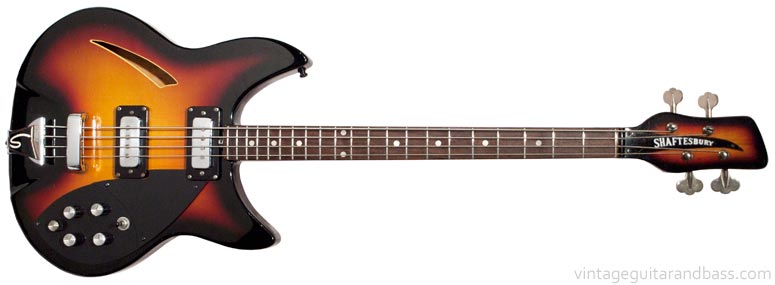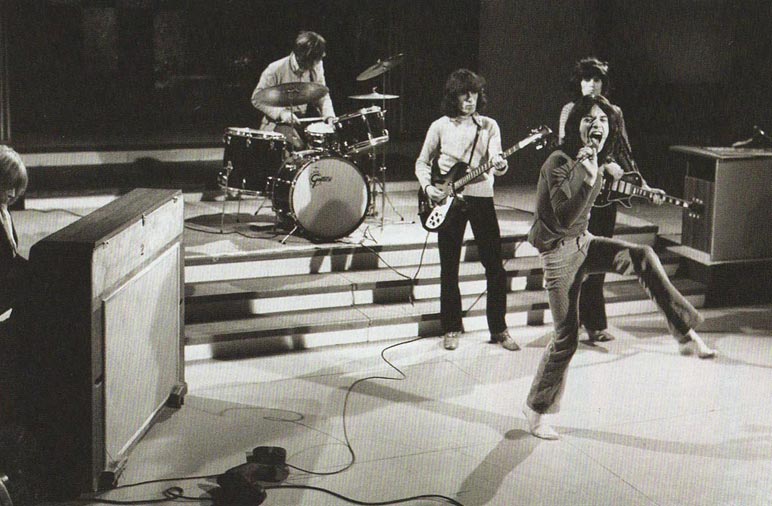
Shaftesbury was the house brand for UK music distributor Rose Morris. It was applied to amps, effects units, drums and of course guitars. The Shaftesbury 3263 bass was one of the very first models (alongside the 3261, and twelve string 3262) to sport this marque, the range being first demonstrated in August 1968 at the British Musical Instrument Trade Fair, Russell Square, London. It was available from Rose Morris right through to 1972, and then again in late 1973/74 (see below).
All three Shaftesbury Ric-style models were based on the early 1960s Rickenbacker 360. Of course, there was no bass equivalent to this guitar, so the Shaftesbury 3263, despite it's Rickenbacker styling, is not actually a copy of any Rickenbacker bass. It gets referred to as a Rickenbacker 4005 copy, due to it's semi-solid construction, but in truth the two guitars have very little in common.

Shaftesbury guitars and basses generally don't have high profile users, but very soon after the model's launch, in November 1968, Rolling Stone Bill Wyman made an appearance on UK television, miming to Sympathy for the Devil, playing the Shaftesbury 3263 bass. You can check out some VERY grainy footage here (don't bother!). Bill Wyman certainly got through basses, and this one doesn't seem to have made much of an impression on him!
Wyman was interviewed for Andy Babiuk and Greg Prevost's EXCEPTIONAL book Rolling Stones Gear (seriously, buy it!) in 2012:
 The Rolling Stones, November 29th 1968 on the David Frost Show. From Andy Babiuk and Greg Prevost's Rolling Stones Gear
The Rolling Stones, November 29th 1968 on the David Frost Show. From Andy Babiuk and Greg Prevost's Rolling Stones GearRose Morris imported guitars made by Aria (Matsumoku) and Eko, and it is these companies that produced the bulk of Shaftesbury branded guitars. The earliest examples of the 3263 were produced in Japan, and had a set neck, whilst the majority of production (certainly from mid 1969, if not earlier) were made in Italy, with a bolt-on neck construction. There were hardware differences too, of course, the Eko basses fitted with the same bridges, pickups and tuning keys as fitted to other guitars built in the same plant, i.e. Eko and Vox.
The image below shows three subtly different versions of the 3263 bass. The top two images are Japanese guitars, the third an Italian. Notice hardware differences, even between the two Japanese guitars, specifically the tailpiece. Images taken from the 1968, 1970 and 1971 catalogues respectively.

Precisely when this model was discontinued is also a little unclear. It was certainly still available into 1972, but, based on price list inclusions, discontinued at some point before early 1973. However it does seem to have been revived (along with the 3263 six string guitar at the end of 1973 and through most of 1974). Whether it was reissued due to customer demand, or had merely been missed out from a significant chunk publicity remains to be discovered.
Precise dating of these instruments is not generally possible, but there are some features of earlier and later instruments that allow approximate dating. Obviously the earliest Japanese basses date from 1968 (and maybe early 1969). These are easily identified from their set neck and staple type pickups. Beyond that, dating is difficult. Early Eko examples had 10 digit serial numbers stamped into their neck plates. Slightly later ones had 8 digit serial number stickers. These guitars all seem to have had white scratchplates. Examples with black scratchplates may represent the final batches of this instrument, though this is currently conjecture; certainly all early publicity (and guitars so far examined) suggest early examples had white scratchplates.
The Shaftesbury 3263 was included in three catalogues between 1969 and 1971
£183